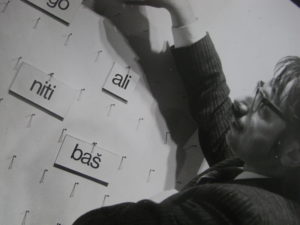
Institute of Contemporary Art announces
Josip Stošić
(1935 – 2009)
Opening of the exhibition:
Thursday, July 10, 2014 at 8:00pm
The exhibition will remain open until August 14, 2014
Gallery hours
Tuesday – Saturday 12:00 to 7:00 p.m.
Sunday – Monday – closed
(August 5, 2014 – closed)
Institute of Contemporary Art,
Trg kralja Tomislava 20, HR – 10000 Zagreb
+385 1 88 97 098, info@scca.hr
support:
City of Zagreb, City Office for Education, Culture and Sports; Ministry of Culture
++++++++++++++++++++++++++++++++++++++++
Five years after the premature passing of Josip Stošić, Institute for Contemporary Art presents the first posthumous exhibition which will display many of his famous works, selected documentation of his artistic oeuvre and several art works and publications for this exhibition for the first time carried out, according to the author sketches.
Josip Stošić is widely known to the public as an art historian who has, by his professional achievements and his personality, marked the Institute for Art History in Zagreb where he worked almost since its inception, until his retirement in 2000.
His artistic career, though still not enough insufficiently researched and published, morphed into an almost cult opus of Croatian contemporary art, especially among those who followed his artistic activities and are familiar with his works.
Perhaps, for wider public, his most famous contribution comes from literary arts, due to in 1951 self-published book “Đerdan” (Neckless), which has been just after the publication censored and banned, which maybe was the reason why Stošić later distanced himself from the world of poetry, but never from the world of words, constitutive and dominant element of his art works.
With this book Stošić has introduced, alongside with Radovan Ivšić, Boro Pavlović and Ivan Slamnig, the concrete poetry in our literature, what was mostly written about by Zvonimir Mrkonjić, Goran Rem, and a row of other authors.
In the film segment of his oeuvre Stošić has collaborated with Darko Schneider as a scriptwriter on two films during the 70ies of the 20th century, and performed and planned film animations with the late Ladislav Galeta.
The art work, which is actually the longest-lasting, and inside of which he was presented at a number of group local or international exhibitions and several solo shows in Croatia, he has collaborated with a number of Croatian artists and curators: Boris Bućan, Zdravko Tišljar, Vladimir Gudci, Ladislav Galeta, Goran Trbuljak , Radoslav butter, Davor Matičević, Richard Demarco ….
Stošićs’ visual art artistic oeuvre is of many media and includes poetry, lyrics, (one minute) dramas, movies, concepts, installations, objects, performative forms, graphic work, photographs …. what will largely be presented in an exhibition at the Institute of Contemporary Art.
With this exhibition we want to bring the body of work of Josip Stošić back to the focus of contemporary art research in Croatia. This is the first exhibition ever, that brings together several of his works from different periods, and represents several of those that he have not had a chance to execute.
The publication alongside the exhibition will be published later this year, with a series of texts by his fellow artists and art historians who are able to discover so far undiscovered knowledge, facts, circumstances in which works have been conceived and significance of works of Josip Stošić.
Josip Stošić, let it be mentioned in the year when the Institute of Contemporary Art is celebrating its 20th anniversary, was a member of the first Advisory Board of then SCCA – Zagreb, from which emerged the Institute for Contemporary Art, and as an artist had taken part at the frst annual exhibition of SCCA – Zagreb.
The exhibition has been prepared with great help and cooperation of the family, Karmen Stošić and Irin Stošić.
Curated by Janka Vukmir.
JOSIP STOŠIĆ
Zagreb February 21, 1935 – July 13, 2009
He has graduated from the Faculty of Philosophy in art history and psychology in 1963.
He worked at the Institute of Art History sinc 1967 until his retirement in 2000.
Photo: Š. Radovčić




